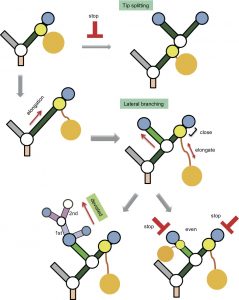北沢さんの修論がJ Anatomyに受諾されました。
ヒト腎臓の尿路樹と腎小体には下記のような不可思議なことが知られています。
- 腎小体は尿路樹の末梢枝のみに結合する
- 尿路樹の枝数は分岐次数が増えても2nで増加しない
これを説明するモデルはいくつか提唱されていましたが、決着していませんでした。
私達はヒト胚子期の腎臓の形成を、尿路樹形成と糸球体形成との相互関係に着目し定量的に詳細に検討しました。得られたデータを合理的に説明できる以下の様なモデルを提唱しました
- 糸球体はCS19に初めて出現、尿路樹への結合がみられる。
- 糸球体の結合した尿路樹の末端の枝 は、先端でさらに先端分岐することはない
- 糸球体の結合した尿路樹の末端の枝 は、結合部位より基部側での分岐 (側方分岐) が継続する
同モデルは、これまで提唱されていた3つのモデルのうちの3番目を支持するものです。
Kitazawa H, Fujii S, Ishiyama H, Matsubayashi J, Ishikawa A, Yamada S, Takakuwa T. Nascent nephrons during human embryonic development: Spatial distribution and relationship with urinary collecting system. J Anatomy 2021; 238, 455-466, in press.DOI: 10.1111/JOA.13308

Abstract
The two major components of the metanephros, the urinary collecting system (UCS) and nephron, have different developmental courses. Nephron numbers vary widely between species and individuals and are determined during fetal development. Furthermore, the development of nascent nephrons may contribute to the expansion of the proximal part of the UCS. This study investigated the distribution of nascent nephrons and their interrelationship with UCS branches during human embryogenesis. We obtained samples from 31 human embryos between Carnegie stages (CSs) 19 and 23 from the Kyoto Collection at the Congenital Anomaly Research Center of Kyoto University in Japan. Serial histological sections of the metanephros with the UCS were digitalized and computationally reconstructed for morphological and quantitative analyses. The three-dimensional (3D) coordinates for the positions of all UCS branch points, end points, attachment points to nascent nephrons (APs), and renal corpuscles (RCs) were recorded and related to the developmental phase. Phases were categorized from phase 1 to phase 5 according to the histological analysis. The UCS branching continued until RCs first appeared (at CS19). End branches with attached nascent nephrons (EB-AP[+]) were observed after CS19 during the fifth generation or higher during the embryonic period. The range of end branch and EB-AP(+) generation numbers was broad, and the number of RCs increased with the embryonic stage, reaching 273.8 ± 104.2 at CS23. The number of RCs connected to the UCS exceeded the number not connected to the UCS by CS23. The 3D reconstructions revealed RCs to be distributed around end branches, close to the surface of the metanephros. The RCs connected to the UCS were located away from the surface. The APs remained near the end point, whereas connecting ducts that become renal tubules were found to elongate with maturation of the RCs. Nascent nephrons in RC phases 3-5 were preferentially attached to the end branches at CS22 and CS23. The mean generation number of EB-AP(−) was higher than that of EB-AP(+) in 19 of 22 metanephros and was statistically significant for eight metanephros at CS22 and CS23. The ratio of the deviated branching pattern was almost constant (29%). The ratio of the even branching pattern with EB-AP(+) and EB-AP(+) to the total even branching pattern increased with CS (9.2% at CS21, 19.2% at CS22, and 45.4% at CS23). Our data suggest the following: EB-AP(+) may not branch further at the tip (i.e., by tip splitting), but branching beneath the AP (lateral branching) continues throughout the embryonic stages. Our study provides valuable data that can further the understanding of the interactions between the UCS and nascent nephrons during human embryogenesis.








